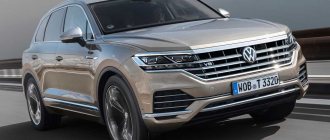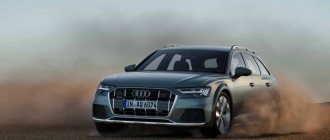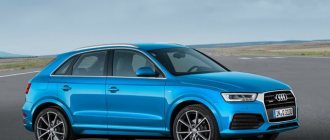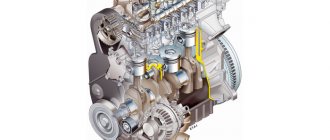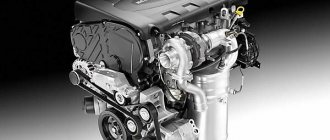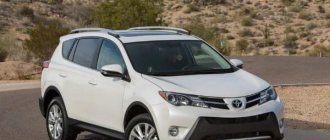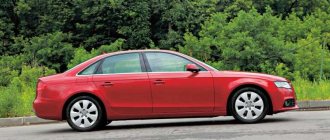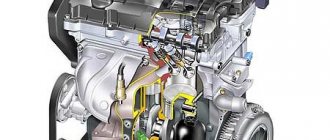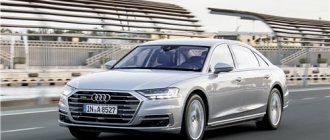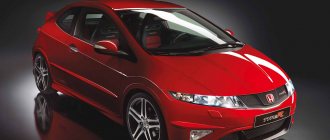The full-size Audi Q7 crossover can be called, without a stretch, a base for testing the scientific developments of German designers in the field of engine building. Despite the fact that the car’s generation history is only two units, and production has so far been limited to fourteen years (from 2005 to 2019), a large number of different engines have been installed under its hood.
Audi Q7 – car and test bench
The history of the Audi Q7
The basis for the creation of the Q7 all-wheel drive crossover was the Pikes Peak quattro concept car (2003, Detroit Auto Show). Car enthusiasts saw the production model of the car for the first time two years later in Frankfurt. Q7 is a “neighbor” on the platform (PL71) and place of creation (Bratislava) of the world-famous cars – Volkswagen Touareg and Porsche Cayenne. The Q7 differs from them in its longer body (5.09 m), in which, depending on the modification and configuration of the car, five or seven people can sit.
For Audi AG, this is the first experience in creating a full-fledged SUV. There were times when designers tried to experiment. For example, some modifications were equipped with an air suspension equipped with a function for changing the ground clearance. The distribution of torque between the front and rear axles in Quattro all-wheel drive is carried out in a ratio of 40:60.
Schematic representation of the PL71 platform
Taking into account the design solution with a gradual decrease in body height, the third row of seats can accommodate passengers with a height of no more than 160 cm. Due to the installation of seats with folding backrests, it is much more difficult to reach it than in a car with reclining seats.
The Q7 crossover is not entirely suitable for driving on rough off-road conditions. This is due to a number of factors:
- “parquet” concept for installing engines and transmissions;
- no downshift;
- body format (self-supporting);
- independent suspension.
Oddly enough, an additional “minus” is the spacious trunk, the layout of which in terms of improving the “all-terrain” capabilities of the car, the designers did not quite get right.
Carbon ceramic brake disc
For milder conditions, that is, driving on highways, city and country roads with limited cross-country ability, a sufficient number of systems and options are included in the Q7 design:
- “adaptive cruise control” (ACC) distance maintenance system;
- adaptive air suspension;
- dynamic cornering lighting system;
- lane change assistant “side assist”;
- parking sensors with rear view camera.
A car phone with Bluetooth interface and SIM Access Profile is available as an option. One of the most powerful cars in the series, the Q7 with a twelve-cylinder V-shaped turbodiesel engine is equipped with carbon-ceramic brakes. Over fourteen years of operation, the car was produced for the countries of the European and American continents. The screwdriver assembly of the Russian version of the Q7 was carried out at the car plant in Kaluga.
Technical specifications of Audi Q7 2018
The technical characteristics of the Audi Q7 provide comfortable driving regardless of the weather or the quality of the road surface. The driver is given the opportunity to choose the optimal driving mode (there are 7 of them in Audi).
The Audi SQ7 combines dynamics, comfort, a spacious interior and impeccable driving. The manufacturer has equipped the luxury sports version with the latest infotainment options. The main performance characteristics are a sensitive response to pedal pressure, precise production of 900 Nm of torque and 422 horses.
Photos of Audi Q7 2018
Engines
Audi Q7 forced to abandon V12 TDI. Environmental regulations are becoming stricter every year, and top models account for a small percentage of sales. All this makes it economically unfeasible to “green” engines with large volumes. Instead of a V12, the Audi Q7 will be equipped with a V8, which is not inferior in power, but costs much less.
The technical characteristics of the Audi Q7 are very impressive. Buyers can choose from engines powered by both gasoline and diesel:
- The basic configuration of the gasoline power unit is boosted and equipped with a turbine, so it is capable of producing 252 hp. It takes just 7 seconds to accelerate to 100 km/h, despite the weight of the Audi Q7.
- The next option is a gasoline engine with a capacity of 3 liters and a power of 333 horses. Acceleration time to the coveted hundred is reduced to 6 seconds, and fuel consumption increases significantly.
- For diesel fans, the Germans have prepared 3-liter engines of various modifications, producing 218 and 272 hp. The acceleration time to 100 km/h is completely similar to its gasoline counterparts, but the reduction in fuel consumption is a nice bonus.
- The sports version of the Audi QS7 is equipped with a V8 4.0 turbodiesel engine (435 hp) with 2 compressors and a supercharger, the operation of which requires a 48 V power supply. Electric charging provides maximum traction starting from 1000 rpm.
Engine for Audi Q7 2018
Transmission
The 2021 Audi Q7 specifications include a single transmission option. The use of an eight-speed Tiptronic automatic reduces fuel consumption by 5 percent. Eight gear ratios eliminate sudden changes in engine speed. Based on a review of the Audi Q7 and reviews from owners, we can say that the transmission provides an engine speed that is close to ideal. The gearbox shifts smoothly and quickly.
Read also All about the Audi A5 dimensions, characteristics and acceleration to 100 km/h
The 8-speed Tiptronic has a wide range of gear ratios – 7.25:1. The lower stages provide dynamic acceleration, and the high ones guarantee a combination of energetic movement and low engine speed. The torque converter's locking clutch prevents slippage even at low speeds. The new damper is able to dampen any vibrations of the power unit.
The characteristics of the Audi Q7 transmission give the driver the right to choose: he can choose mode D or S, or change gears independently, using the selector or steering wheel paddles.
Suspension
The Audi Q7 is a modern car that looks confident under any circumstances.
The suspension design consists of double wishbones mounted on different subframes, guaranteeing precision and sporty handling on asphalt, as well as a smooth and comfortable ride off-road. The main feature of the Audi Q7's adaptive air suspension is varying the ground clearance depending on the circumstances. If the car is moving on a high-speed road, the clearance is reduced, which has a positive effect on directional stability. Rough terrain requires increased ground clearance. The standard MMI terminal provides the driver with a choice of one of 5 modes: comfort, automatic, dynamic, off-road, increased clearance.
Steering and braking system
According to reviews from owners, the Audi Q7 steering wheel is comfortable in thickness and diameter, and the leather upholstery is pleasant to the hands. The operation of the Servotronic power steering is directly dependent on the current acceleration of the vehicle.
The front and rear wheels of the Audi Q7, regardless of configuration, are equipped with ventilated disc brakes that support an anti-lock braking system. An additional plus is the presence of a servo amplifier.
Safety
The Audi Q7 has many airbags: front and rear on the sides, adaptive for the driver and front passenger, as well as overhead. The entire set is regulated by the control unit. Passive safety, depending on the version, includes:
- impact sensors from the front, in the doors, in the pillars, in the longitudinal direction, in the pedestrian protection system;
- inertial belts with electric and pyrotechnic type pretensioners;
- warning about unfastened seat belt on any seat;
- a squib protecting pedestrians;
- device that disconnects the battery.
According to the crash test results, the Audi Q7 provides safety:
- driver or adult passenger - by 92%;
- child – by 86%;
- pedestrians and other vulnerable road users – by 71%.
Read also All the details about the Audi Q5 car line
Ensuring security through devices scored 73%:
- speed control 1.7 points out of 3 possible;
- a warning light indicating an unfastened seat belt – 2.5 out of 3;
- an assistant who keeps the car on the lane in accordance with the markings - 2.8 out of 4;
- safety program for trips outside the city - 2.5 out of 3.
The manufacturer has equipped the Audi Q7 with a large number of auxiliary assistant programs. Audi side assist guarantees safe changing of lanes to the right or left at speeds from 15 km/h. The rear bumper is equipped with 2 radar sensors that measure a distance of up to 70 meters. If another car is in the blind spot or is approaching at high speed, then the driver sees a warning signal in the outside mirror.
The cross-traffic control program ensures safe exit from the parking lot. Turns on automatically when reverse and low speed are combined. The trailer reversing assistant automatically selects the optimal direction without driver intervention.
The presence of adaptive cruise control is important for travelers and people who spend a lot of time traveling. Rangefinder sensors track obstacles at a distance of up to 250 meters and regulate the speed limit. The combination of cruise control and a front camera enables Audi pre sense front to prevent collisions with the vehicle ahead.
Audi Q7 2021 Premium
The first car of the second generation
One of the most dynamic and nearby markets for German automakers is the Russian Federation. It is no coincidence that the first second-generation Q7 car began to be sold in our country. This is an all-wheel drive three-liter diesel engine with an automatic transmission. The engine code is CRTC. Below we will dwell in more detail on why most Q7 cars were equipped with turbocharged diesel engines with a volume of 2967 cm3, as well as on some of their features.
New Q7 design
And now a few words about the new car. The designers did their best: the 2021 Audi Q7 turned out to be worthy competitors of the best modern heavy crossovers Acura MDX, Infiniti QX60 and Lincoln Aviator. The main message is the abandonment of large-volume engines in favor of two-liter (252 hp) and three-liter (333 hp) diesel engines with a turbine as a supercharger.
The standard of recent years for Q7 crossovers is eight-speed automatic transmissions. The car is characterized by high efficiency: average fuel consumption does not rise above 7.7-8.0 l/100 km. The all-wheel drive vehicle accelerates to 100 km in 6.1 seconds.
Installation diagram for Bang&Olufsen audio system speakers
At the customer's request, the vehicle can be equipped with the latest highly automated optional equipment. In addition to ideal comfort, there is an Audi feature of recent years for all premium cars: the journey in the car is accompanied by a unique music system from the Hi-End market leader, . It is installed optionally, and on production models there is a Bose audio system.
Engines for Audi Q7
The range of power units that were installed on the Q7 crossovers is quite wide - from internal combustion engines with direct fuel injection to turbocharged engines and a range of V6-V12 diesel engines. The apotheosis of design research was the installation of a six-liter V12 diesel engine with a total power of 500 hp under the hood of the car.
| Marking | Type | Volume, cm3 | Maximum power, kW/hp | Peculiarities |
| CATA | diesel turbocharged | 2967 | 165/225 | Common Rail |
| BHK | petrol | 3597 | 206/280 | direct injection |
| BAR | petrol turbocharged | 4163 | 257/350 | direct injection |
| CJTC, CJWC | —:— | 2995 | 200/272 | direct injection |
| BUG | diesel turbocharged | 2967 | 171/233 | Common Rail |
| CJGA, CNRB, CASA, CCMA | —:— | 2967 | 177/240 | Common Rail |
| BTR | —:— | 4134 | 240/326 | Common Rail |
| CCGA | —:— | 5934 | 368/500 | Common Rail |
| C.J.G.K., C.J.M.A. | —:— | 2967 | 150/204 | Common Rail |
| CJGD, CLZB, CRCA | —:— | 2967 | 180/245 | Common Rail |
| CJTB, CJWB, CNAA, CTWA | petrol turbocharged | 2995 | 245/333 | direct injection |
| CCFC, CCFA | diesel turbocharged | 4134 | 250/340 | Common Rail |
| CZZA, CZZB | —:— | 2967 | 160/218 | Common Rail |
| CVZA | —:— | 2967 | 190/258 | Common Rail |
| CRTC | —:— | 2967 | 183/249, 200/272 | Common Rail |
| CREC | petrol with compressor | 2995 | 245/333 | DOHC, direct injection |
| CYMC, CYRB | petrol turbocharged | 1984 | 185/252 | direct injection |
| CVMD | diesel turbocharged | 2967 | 1831/249 | Common Rail |
As you can see, Audi AG engine engineers, working to improve the performance characteristics of the power plant, experimented a lot in the form factor of three-liter diesel engines: a third of turbocharged engines have the same volume - 2967 cm3.
One motor, designed for a small series of cars sold in the Russian Federation and European countries, amazes with its uniqueness and price (4.5 million rubles). It’s easy to guess that we are talking about a 5.9-liter turbodiesel with 500 hp. – CCGA motor. It is arranged in a double V-pattern with a 60° camber. The process of its creation is shrouded in mystery, but knowledgeable people said, for example, that the crankshaft is nothing more than a compilation of Le Mans R10.
CCGA designers hid everything possible from prying eyes
Not everyone, even a very professionally trained driver, can hold a car equipped with a power plant with a CCGA engine during takeoff. The power plant is equipped with not one, but two ECUs with a vertical interaction pattern. Without the “permission” of the master unit, the slave will not authorize any action initiated by the driver if it is contrary to the operating instructions.
The engine starts and runs amazingly quietly. In order to detect changes in the parameters of its functioning, you need very good hearing, and also a stand equipped with automatic equipment. The maximum engine torque is an unimaginable 1000 Nm, and the average fuel consumption is only 11.3 liters. For an engine of such a huge volume, the emissions of harmful gases are also very modest - 298 g/km.
The most popular engine for the Audi Q7
The Q7 crossover is one of those cases where the designers did not lean towards one or more engine models. The engines are distributed fairly evenly among the trim levels. And yet, there is a model that was entrusted several times to “start” sales of the model in several countries at once. We are talking about the FSI engine with the factory index BHK - a 3.6-liter gasoline engine produced by the Volkswagen concern (2005-2010), made for an automatic transmission. This is the only engine without a supercharger in the entire Audi Q7 series.
Engine BHK
When installing the engine on the first assemblies of the Q7 model in Europe, the Russian Federation and the USA, the design team carried out a comprehensive check of the technical equipment and capabilities of the power plant. Only after this did cars begin to be equipped with more powerful turbodiesels. BHK Engine Features:
- direct fuel injection system;
- double-chain timing drive;
- compression ratio – 12.
The material used for the VR6 cylinder block is cast iron, the 24V cylinder head is aluminum. Oil type – 5W30. Filling volume – 6.9 l.
For a motor designed to meet Euro IV environmental standards, the designers set a fairly high performance “ceiling” - 330 thousand km. The reason why this internal combustion engine was subsequently replaced by three-liter diesel engines is simple - it is too gluttonous. Judge for yourself: with an average consumption outside the city of 9.2 liters, in combined mode - 12.4 liters, when entering the city limits, gasoline costs doubled (18.0 l/100 km).
Diagram of a double-chain timing drive for 2.7-3.0-liter diesel engines
During operation, owners of a Q7 with a BHK engine helped the designers compile a short but very impressive list of its “cons”:
- low resource of fuel injection pump, timing chains and ignition coil;
- frequent failure of crankcase ventilation;
- accumulation of condensate in the exhaust system in winter, making it difficult to start the engine;
- the need for regular decoking due to the formation of carbon deposits on the intake valves.
Coupled with cost-effectiveness, this was enough to stop production by 2010.
Advantages and disadvantages
According to owner reviews, the Audi Q7 is a car that has surpassed Mercedes-Benz and BMW. In the first, comfort is inferior, and in the second, dynamics and controllability. After the plant decided to update the car, the Audi Q7 began to feel like a passenger car. Under normal operating conditions of the air suspension, the clearance height is from 180 to 200 mm, which ensures good cross-country ability on roads in Russia. Driving at low speeds allows you to increase ground clearance to 248 mm.
The next review is about the Audi Q7 with a 3-liter diesel engine. With an average speed of 110 km/h and a mileage of 1800 km, the actual consumption was 10.3 liters. Among the advantages, the owners highlight: a spacious interior, good handling, excellent sound insulation.
The fuel tank neck, which requires the use of a Euro gun, is noted as a design flaw, with which a maximum of 40% of gas stations in Russia are equipped.
After how many kilometers do you need to change consumables? Oil after approximately 12-13 thousand km. mileage, front pads - after 18 thousand km, rear pads - after 27 thousand km.
Audi Q7 2021 in white
